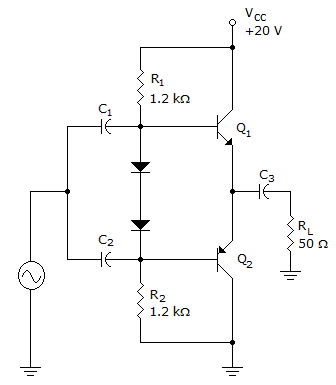Electronic Devices - Power Amplifiers - Discussion
Discussion Forum : Power Amplifiers - General Questions (Q.No. 2)
2.
Calculate VB2.


Discussion:
11 comments Page 1 of 2.
JJ T said:
1 decade ago
Hello, I am curious as to why 9.3V is the answer.
If we have 20 Vcc across a branch of resistance totaling R1 + D1 + D2 + R2, which is 1200 + 0.7 +0.7 + 1200 = 2401.4 Ohm.
If I run a voltage divider on this at VB2, I am getting 1200/2401.4(20) = which is 9.99V.
I tried to do it using voltage drops as well and I am still getting about 10V at VB2.
Could you please let me know if I am doing something wrong?
If we have 20 Vcc across a branch of resistance totaling R1 + D1 + D2 + R2, which is 1200 + 0.7 +0.7 + 1200 = 2401.4 Ohm.
If I run a voltage divider on this at VB2, I am getting 1200/2401.4(20) = which is 9.99V.
I tried to do it using voltage drops as well and I am still getting about 10V at VB2.
Could you please let me know if I am doing something wrong?
Rathi said:
1 decade ago
It is simple.
Voltage at the point between two diode is 10v(Vcc/2).
i.e. R1 + D1 + D2 + R2 voltage drops is 9.3 + 0.7 + 0.7 + 9.3 = 20v.
So VB2 = 9.3V.
Voltage at the point between two diode is 10v(Vcc/2).
i.e. R1 + D1 + D2 + R2 voltage drops is 9.3 + 0.7 + 0.7 + 9.3 = 20v.
So VB2 = 9.3V.
Digvijay said:
6 years ago
See do dc analysis i.e open ckt all capacitors.
Then by kvl in loop of r1 d1 d2 r2.
20=i(1.2k+1.2k)+.7+.7,
So, i=7.75mA.
So drop at base= 1.2k * 7.75mA= 9.3V.
Then by kvl in loop of r1 d1 d2 r2.
20=i(1.2k+1.2k)+.7+.7,
So, i=7.75mA.
So drop at base= 1.2k * 7.75mA= 9.3V.
(5)
Abdul naweed said:
9 years ago
v/g across each diode is 10 v a considering diode as a diode as a silicon the vk of silicon is 0.7 therefore 10 - 0.7 give 9.3 v.
Saila said:
1 decade ago
One confusion is how could you consider R1 as 9.3. Please answer.
A.Manoj Kumar said:
9 years ago
I am not getting this, Please explain the answer.
Anomi said:
7 years ago
Vcc-.7-.7 = 18.6.
(R2/(r1+r2))(18.6) = 9.3.
(R2/(r1+r2))(18.6) = 9.3.
Harsh said:
5 years ago
@Digvijay.
Thank you for explaining.
Thank you for explaining.
Biradar Mayuri said:
5 years ago
Nice explanation. Thanks all.
Pragati said:
6 years ago
Please explain in detail.
Post your comments here:
Quick links
Quantitative Aptitude
Verbal (English)
Reasoning
Programming
Interview
Placement Papers